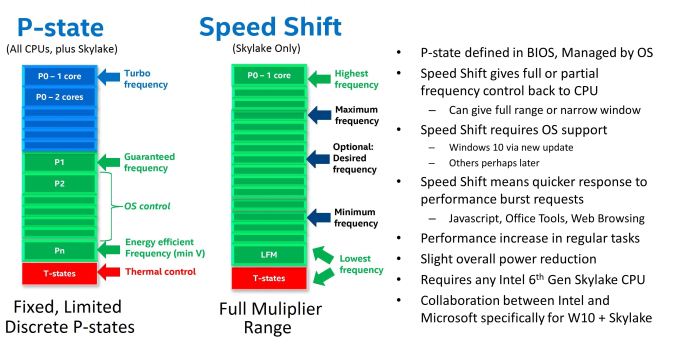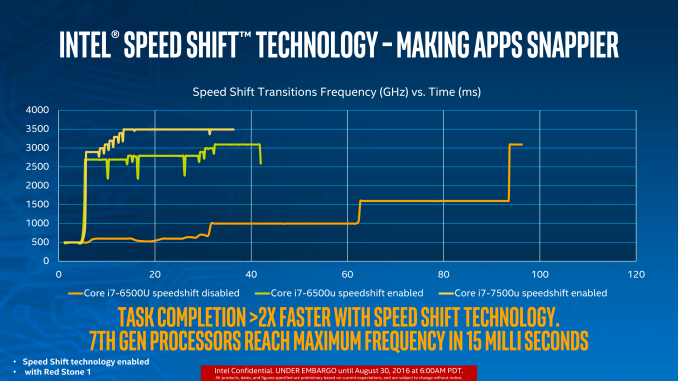Intel Launches 7th Generation Kaby Lake: 15W/28W with Iris, 35-91W Desktop and Mobile Xeon
by Ian Cutress on January 3, 2017 12:01 PM ESTSpeed Shift v2: Speed Harder
As originally reported at Kaby Lake-Y/U Launch
One of the new features for Skylake was Speed Shift. With the right OS driver, the system could relinquish control of CPU turbo to the CPU itself. Using internal metric collection combined with access to system-level sensors, the CPU could adjust the frequency with more granularity and faster than the OS can. The purpose of Speed Shift was to allow the system to respond quicker to requests for performance (such as interacting with a touch screen or browsing the web), reduce delays and improve the user experience. So while the OS was limited to predefined P-state options, a Speed Shift enabled processor with the right driver had a near contiguous selection of CPU multipliers within a wide range to select from.
The first iteration of Speed Shift reduced the time for the CPU to hit peak frequencies from ~100 milliseconds down to around 30. The only limitation was the OS driver, which is now a part of Windows 10 and comes by default. We extensively tested the effects of the first iteration of Speed Shift at launch.
With Kaby Lake, the hardware control around Speed Shift has improved. Intel isn’t technically giving this a new name, but it is an iterative update which I prefer to call ‘v2’, if only because the adjustment from v1 to v2 is big enough to note. There is no change in the OS driver, so the same Speed Shift driver works for both v1 and v2, but the performance means that a CPU can now reach peak frequency in 10-15 milliseconds rather than 30.
The light green and yellow lines show the difference between v1 and v2, with the yellow Kaby Lake processor getting up to 3.5 GHz incredibly quickly. This will have an impact on latency limited interactions as well as situations where delays occur, such as asynchronous web page loading. Speed Shift is a play for user experience, so I’m glad to see it is being worked on. We will obviously have to test this when we can.
A note about the graph, to explain why the lines seem to zig-zag between lower and higher frequencies because I have encountered this issue in the past. Intel’s test, as far as we were told, relies on detecting register counters that increment as instructions are processed. By monitoring the value of these registers, the frequency can be extrapolated. Depending on the polling time, or adjacent point average (a common issue with counter based time benchmarks I’ve experienced academically), it can result it statistical variation depending on the capability of the code.
While this graph uses the i7-7500U, which was released back in September, Speed Shift v2 is a feature for all Kaby Lake processors in the stack with the right OS. We still have not received an official word if Intel is working closely with Apple to bring the feature to macOS, or even if it will be promoted if it ever makes the transition – Apple may never promote it so as not to confuse the non-technical media that follow Apple, but also not allow Intel to specify that Apple is using it. Or, it’ll be part of a presentation; we don’t know.












43 Comments
View All Comments
Lolimaster - Tuesday, January 3, 2017 - link
It's the same damn skylake with a more "mature" process. Before you could call that "release new models" like FX8350 and later the 8370.Calling it a new generation is laughable. Haswell refresh got the 4790K after the initial 4770K,
marc1000 - Friday, January 6, 2017 - link
even as some specific benchmarks show 20% to 30% improvements over 2600k, when I look at gaming I loose all interest to upgrade. my computer is either idle (browsing or light use) or is gaming. to 90% of users with a "generic" profile, there is hardly any reason to leave a Sandy-bridge computer.of course, ultra-thin notebooks and other low-power equipments can put the newer cpus to good use. but wherever a 2600k can already fit, there is no reason to change it. I am keeping my 2500k for yet another cycle here... (maybe this is the result of a lack of competition for some years???)
@Ian, if possible please include a comparison of a 2500k or 2600k Sandy at 4Ghz vs the newer 7600 or 7700 processors. if this is possible of course.
limitedaccess - Tuesday, January 3, 2017 - link
So $305 is the official MSRP? This makes it cheapest mainstream i7 k series release yet?According to Anandtech's review even the first 2600k had a higher $317 MSRP, 3770k was the previous lowest at $313.
Ken_g6 - Tuesday, January 3, 2017 - link
Ars Technica says it's $350, not $305. Typo?http://arstechnica.com/gadgets/2017/01/intel-core-...
limitedaccess - Tuesday, January 3, 2017 - link
Looking at some other reviews, Tom's, Techreport and PCPer say $339.cfenton - Tuesday, January 3, 2017 - link
On the final page it says, "At the end of the day, the Core i7-7700K... has a tray price of $305. This means it will probably reach shelves around $330-$350, and we haven’t heard about a new stock cooler so it will probably come without one."So $305 is the tray price and retail will be $330-$350.
Casper42 - Tuesday, January 3, 2017 - link
> I highly suspect that the Xeon CPUs will be announced later in Q1, given that the target market for these is a little different to standard desktop processors.Late March
chucky2 - Tuesday, January 3, 2017 - link
I hope in the chipset review piece you're doing later, you address what future CPU's will be supported under series 200 socket 1151 motherboards. For example, is Intel committing to Coffee Lake support on these boards? Cannonlake? I.e. How much longevity are we going to get with these boards? Same same on the Xeon boards front for it's chipset.TEAMSWITCHER - Tuesday, January 3, 2017 - link
I'm thinking the longevity will be very short. Z270 is to Z170 ... just as ... Z97 was to Z87. Intel's 10 nm processors will probably introduce a new socket.chucky2 - Wednesday, January 4, 2017 - link
If Z270 really is like Z97, that will be a complete joke.I'm starting to wonder if the physical limits have basically been reached, and we're slowly (whether by Corp design or physics, or, some of both), just hitting the wall and this is essentially it.